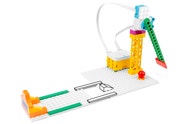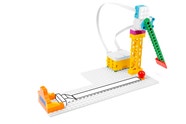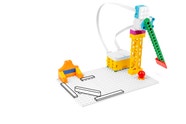SPIKE™ Essential
Mini Mini-Golf
Test your skills with Sofie’s mini-golf game!
30-45 min.
Beginner
Grades 3-5

Prepare
- Review the Mini Mini-Golf lesson in the LEGO® Education SPIKE™ App.
- If necessary, pre-teach these related vocabulary words: energy, motion, program, test, and upgrade.
- Consider the abilities and backgrounds of all your students. Differentiate the lesson to make it accessible to everyone. See the Differentiation section below for suggestions.
- If time allows, plan and facilitate the math extension. See the Extension section below for more information.
Engage
(Whole Class, 5 Minutes)
- Facilitate a quick discussion about how an object's speed is related to the amount of energy it has.
- Talk with your students about a moving ball (e.g., a ball that's rolling down a hill or being kicked across a soccer field).
- Ask questions, like: Which ball has more energy: a ball that isn't moving or a ball that's rolling down a hill? How could you change the energy of the ball?
- Introduce your students to the story’s main characters and the first challenge: trying to get a hole in one with the mini-golf game.
- Distribute a brick set and a device to each group.
Explore
(Small Groups, 30 Minutes)
- Have your students use the LEGO® Education SPIKE™ App to guide them through their first challenge:
- Create and test the program to get a hole in one.
- Have your students iterate and test their models to complete the next two challenges in the app:
- Modify the program to improve the mini-golf game.
- Upgrade the mini-golf game to make it more challenging.
- You can find coding and building support in the Tips section below.
Explain
(Whole Class, 5 Minutes)
- Gather your students together to reflect on their completed challenges.
- Ask questions, like: How did you modify your program to make sure the ball had enough energy to get a hole in one? How did the speed of the mini-golf club affect the ball's energy?
Elaborate
(Whole Class, 5 Minutes)
- Prompt your students to discuss and reflect on the relationship between an object’s speed and its energy.
- Ask questions, like: What could you do to an object to increase the amount of energy it has? Why is it important to know about the relationship between speed and the amount of energy an object has?
- Have your students clean up their workstations.
Evaluate
(Ongoing Throughout the Lesson)
- Ask guiding questions to encourage your students to “think aloud” and explain their thought processes and reasoning in the decisions they've made while building and programming.
Observation Checklist
- Measure your students’ proficiency in describing the relationship between an object's speed and its energy.
- Create a scale that matches your needs. For example:
- Needs additional support
- Can work independently
- Can teach others
Self-Assessment
- Have each student choose the brick that they feel best represents their performance.
- Yellow: I think I can describe the relationship between an object's speed and its energy.
- Blue: I can describe the relationship between an object's speed and its energy.
- Green: I can describe the relationship between an object's speed and its energy, and I can help a friend do it too.
Peer-Feedback
- In their small groups, have your students discuss their experiences working together.
- Encourage them to use statements like these:
- I liked it when you…
- I'd like to hear more about how you…
Tips
Coding Tip
- After your students complete their first challenge, they'll be provided with three Inspiration Coding Blocks to help them modify their programs.
- The Inspiration Coding Blocks are intended to spark their imaginations as they experiment to find their own solutions.




Model Tip
- After your students complete their second challenge, they’ll be provided with three Inspiration Images and an open-ended prompt for improving their models.
- The Inspiration Images are to help spark their imaginations as they experiment and change their models.




There aren't any building instructions for this challenge.
Differentiation
Simplify this lesson by:
- Shortening the lesson to only include the first challenge
- Selecting one Inspiration Image to help your students change their models
Increase the difficulty by:
- Changing the mini-golf club design to see how it impacts the ball's speed
- Exploring new and different coding blocks in the program
Extension
- Have your students investigate line-symmetric figures in the Mini Mini-Golf lesson. Ask them to record the different angles of the mini-golf club, and then draw and label the figures and all relevant parts (e.g., parallel lines, perpendicular lines, angles).
If facilitated, this will extend beyond the 45-minute lesson.
Math: CCSS.MATH.CONTENT.4.G.A.3
Teacher Support
Students will:
- Explore the basic principles of energy and their connection to an object's speed
- Identify and describe the relationship between speed and energy
- Engage effectively in a range of collaborative discussions
(one for every two students)
- LEGO® Education SPIKE™ Essential Set
- Device with the LEGO® Education SPIKE™ App installed
- CSTA 1B-DA-07
- NGSS 4-PS3-1
- ISTE 1.3d
- CCSS.ELA-LITERACY.SL.4.1
- CCSS.MATH.CONTENT.4.MD.C.5
Math Extension
- CCSS.MATH.CONTENT.4.G.A.3




